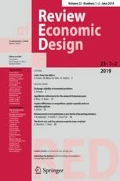Abstract
To overcome deficits of the Lindahl solution concept when the economy does not exhibit constant returns to scale, Kaneko (1977a) introduced the concept of aratio equilibrium. Theratio correspondence selects for each economy its set of ratio equilibrium allocations. In this paper we provide a simple market game thatdouble implements the ratio correspondence in Nash and strong equilibria.
Similar content being viewed by others
References
Aghion, P., 1985, On the generic inefficiency of differentiable market games, Journal of Economic Theory 37, 146.
Benassy, J.-P., 1986, On competitive market mechanisms, Econometrica 54, 108.
Calsamiglia, X., 1977, Decentralized resource allocation and increasing returns, Journal of Economic Theory 14, 263–283.
Diamantaras, D. and S. Wilkie, 1994, A generalization of Kaneko's ratio equilibrium for economies with public and private goods, Journal of Economic Theory 62, 499–512.
Dutta, B. and A. Sen, 1991, Implementation under strong equilibrium: A complete characterization, Journal of Mathematical Economics 20, 67.
Foley, D., 1970, Lindahl's solution and the core of an economy with public goods, Econometrica 38, 66–72.
Groves, T. and J. Ledyard, 1987, Incentive compatibility since 1972, In: T. Groves, R. Radner and S. Reiter, eds., Information incentives and economic mechanisms: Essays in honor of Leonid Hurwicz (University of Minnesota Press, Minneapolis, MN).
Hurwicz, L., 1972, On informationally decentralized systems, In: T. McGuire and R. Radner, eds., Decision and organization (North-Holland, Amsterdam).
Hurwicz, L., 1979a, On allocations attainable through Nash equilibria, Journal of Economic Theory 21, 149–165.
Hurwicz, L., 1979b, Outcome functions yielding Walrasian and Lindahl equilibria at Nash equilibria points, Review of Economic Studies 46, 217–215.
Hurwicz, L., E. Maskin and A. Postlewaite 1984, Feasible implementation of social choice correspondences by Nash equilibria, Manuscript (University of Minnesota, Minneapolis MN).
Kaneko, M., 1977a, The ratio equilibrium and a voting game in a public good economy, Journal of Economic Theory 16, 123–136.
Kaneko, M., 1977b, The ratio equilibria and core of the voting GameG(N,W) in a public goods economy, Econometrica 45, 1589–1594.
Kwan, Y.K. and S. Nakamura, 1990, On Nash implementation of the Walrasian or Lindahl correspondence in the two agent economy, Discussion paper no. 243 (University of Minnesota, Minneapolis, MN)
Mas-Colell, A. and J. Silvestre, 1989, Cost share equilibria, Journal of Economic Theory 47, 239–256.
McKelvey, R.D., 1989, Game forms for Nash implementation of general social choice correspondences, Social Choice and Welfare 6, 139–156.
Maskin, E., 1977, Nash equilibrium and welfare optimality, Unpublished manuscript, (MIT, Cambridge, MA).
Maskin, E., 1985, The theory of Nash implementation: A survey, In: L. Hurwicz, D. Schmeidler and H. Sonnenschein, eds., Social goals and social organization (Cambridge University Press, New York).
Moulin, H., 1989, Axioms of cooperative decision making (Cambridge University Press, New York).
Peleg, B., 1996, A continuous double implementation of the constrained Walras equilibrium, Economic Design 2, 89–97.
Peleg, B., 1996, Double implementation of the Lindahl equilibrium by a continuous mechanism, Economic Design, this issue.
Saijo, T., 1988, Sufficient conditions for Nash implementation, Econometrica 56, 693–700.
Saijo, T., 1991, Incentive compatibility and individual rationality in public good economies, Journal of Economic Theory 55, 203–212.
Samuelson, P., 1954, The pure theory of public expenditure, Review of Economics and Statistics 36, 387–389.
Schmeidler, D., 1980, Walrasian analysis via strategic outcome functions, Econometrica 48, 1585–1593.
Tian, G., 1989, Implementation of the Lindahl correspondence by a single-valued, feasible and continuous mechanism, Review of Economic Studies 56, 613–621.
Tian, G., 1988, On the constrained Walrasian and Lindahl correspondences, Economics Letters 26, 299–303.
Vega-Redondo, F., 1985, Nash implementation of the Lindahl performance standard, Economics Letters 19, 109–112.
Walker, M., 1981, A simple incentive compatible mechanism for attaining Lindahl allocations, Econometrica 49, 65–71.
Wilkie, S., 1989, Solutions for economies with public goods: Some simple axiomatic approaches, Mimeo. (Bellcore, Morristown, New Jersey).
Author information
Authors and Affiliations
Rights and permissions
About this article
Cite this article
Corchon, L., Wilkie, S. Double implementation of the ratio correspondence by a market mechanism. Economic Design 2, 325–337 (1996). https://doi.org/10.1007/BF02499139
Received:
Revised:
Issue Date:
DOI: https://doi.org/10.1007/BF02499139



